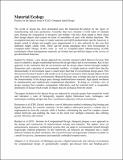Material ecology
Author(s)
Oxman, Neri; Ortiz, Christine; Gramazio, Fabio; Kohler, Matthias
DownloadCAD preface oxman FINAL.pdf (60.61Kb)
PUBLISHER_CC
Publisher with Creative Commons License
Creative Commons Attribution
Terms of use
Metadata
Show full item recordAbstract
The world of design has been dominated since the Industrial Revolution by the rigors of manufacturing and mass production. Assembly lines have dictated a world made of standard parts framing the imagination of designers and builders who have been taught to think about their design objects and systems in terms of assemblies of parts with distinct functions. The assumption that parts are made of single material and fulfill predetermined specific functions is deeply rooted in design and usually goes unquestioned; it is also enforced by the way that industrial supply chains work. These age-old design paradigms have been reincarnated in Computer-aided Design (CAD) tools as well as Computer-aided Manufacturing (CAM) technologies where homogeneous materials are formed into pre-defined shapes at the service of pre-determined functions.
Date issued
2015-03Department
Massachusetts Institute of Technology. Department of Materials Science and Engineering; Massachusetts Institute of Technology. Media LaboratoryJournal
Computer-Aided Design
Publisher
Elsevier B.V.
Citation
Oxman, Neri, Christine Ortiz, Fabio Gramazio, and Matthias Kohler. “Material Ecology.” Computer-Aided Design 60 (March 2015): 1–2.
Version: Author's final manuscript
ISSN
00104485